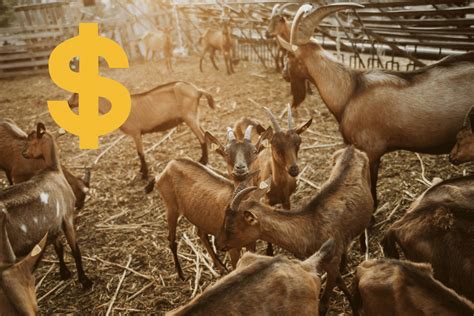Introduction

Goats are versatile and adaptable animals that play a crucial role in agriculture and rural communities worldwide. Their economic value stems from their milk, meat, fiber, and other byproducts. Understanding the cost of acquiring a goat is essential for potential buyers and investors.
Factors Influencing Goat Prices
Determining the price of a goat is influenced by several factors:
- Breed: Different breeds vary in size, production capabilities, and desirability, affecting their market value.
- Age: Younger goats typically cost less than adult goats, as they require additional care and time to mature.
- Health: Goats with good health and proper vaccinations command higher prices.
- Purpose: Goats intended for breeding or milk production fetch higher prices than those destined for meat production.
- Location and availability: Regional demand and supply dynamics can impact goat prices.
Average Goat Prices in 2025
Region/Country | Average Price
—|—|
United States | $200 – $600
United Kingdom | £150 – £500
India | ₹15,000 – ₹30,000
Brazil | R$1,000 – R$3,000
Note: These prices are estimates and may vary depending on specific factors and market fluctuations.
Table 1: Goat Price Comparison by Breed
Breed | Average Price
—|—|
Alpine | $300 – $600
Boer | $500 – $1,000
Nubian | $250 – $500
Pygmy | $200 – $400
Saanen | $400 – $800
Goat Price Breakdown
| Cost Component | Average Range |
|---|---|
| Purchase price | $200 – $600 |
| Monthly feed and care | $50 – $100 |
| Veterinary care | $100 – $300 |
| Breeding fees (if applicable) | $100 – $500 |
| Housing and fencing | $200 – $500 |
| Insurance (optional) | $50 – $100 |
Table 2: Goat Maintenance Costs
Item | Average Monthly Cost
—|—|
Feed and hay | $50 – $75
Water | $15 – $25
Pasture rent (if applicable) | $20 – $50
Veterinary care | $20 – $50
Tips and Tricks for Saving Money on Goats
- Consider breed choice: Opt for breeds with lower purchase prices and maintenance costs.
- Purchase in groups: Buying multiple goats at once can often secure discounts.
- Negotiate with breeders: Discuss payment plans or bulk discounts when purchasing from breeders.
- Take advantage of local resources: Explore community programs or agricultural extension services that may offer financial assistance.
- DIY maintenance: Perform basic care tasks, such as hoof trimming and deworming, to reduce veterinary expenses.
Reviews
“I recently purchased an Alpine goat for $350, and its milk production has exceeded my expectations.” – Sarah, a goat farmer
“Boer goats are known for their meat quality, and I have found them to be a profitable investment.” – John, a livestock producer
“Nubian goats are a great option for those interested in cheesemaking due to their high milk yield with a buttery flavor.” – Mary, a homesteader
“Pygmy goats are adorable and make excellent companion animals, but they require special care.” – Emily, a suburban resident
Highlights and How to Stand Out
- Milk-producing breeds, such as Saanen and Nubian, command higher prices due to their dairy potential.
- Healthy goats with proper vaccinations and a clean bill of health are worth more than those with health issues.
- Investing in infrastructure, such as good fencing and housing, can enhance goat value and longevity.
- Establishing a reputable breeder or farm can increase demand and drive up prices.
Future Trends and How to Improve
- Emerging markets: Goat farming is expanding in regions such as Asia and Africa, creating new opportunities for market growth.
- Sustainable practices: Implementing eco-friendly farming practices can enhance goat health and appeal to consumers seeking ethical products.
- Genetic advancements: Technological advancements in selective breeding are improving goat breed characteristics and production capabilities.
- Value-added products: Exploring the development of goat fiber products, such as cashmere and mohair, can create additional revenue streams.
- Urban goat ownership: As suburban and urban areas embrace small-scale animal keeping, there may be an increased demand for companion goats.
Conclusion
The cost of acquiring a goat can vary significantly depending on factors such as breed, age, location, and purpose. By understanding these factors and considering the ongoing costs of maintenance, potential buyers can make informed decisions when purchasing goats. By embracing best practices and staying abreast of emerging trends, goat owners can optimize their investment and contribute to the sustainability and profitability of the goat industry.
Table 3: Goat Production Costs by Purpose
| Purpose | Average Annual Costs |
|---|---|
| Meat production | $1,000 – $2,000 |
| Milk production | $1,500 – $3,000 |
| Breeding | $2,000 – $5,000 |
Table 4: Innovative Goat Applications
| Application | Potential Benefits |
|---|---|
| Goat milk soap | Antibacterial and moisturizing properties |
| Goat fiber clothing | Soft, warm, and breathable |
| Goat manure fertilizer | Rich in nutrients for plant growth |
| Adventure goat tourism | Unique and immersive animal interactions |
| Goat herding for vegetation management | Cost-effective and environmentally friendly |


